child restraint TOYOTA TACOMA 2013 (in English) User Guide
[x] Cancel search | Manufacturer: TOYOTA, Model Year: 2013, Model line: TACOMA, Model: TOYOTA TACOMA 2013Pages: 524, PDF Size: 10.96 MB
Page 106 of 524
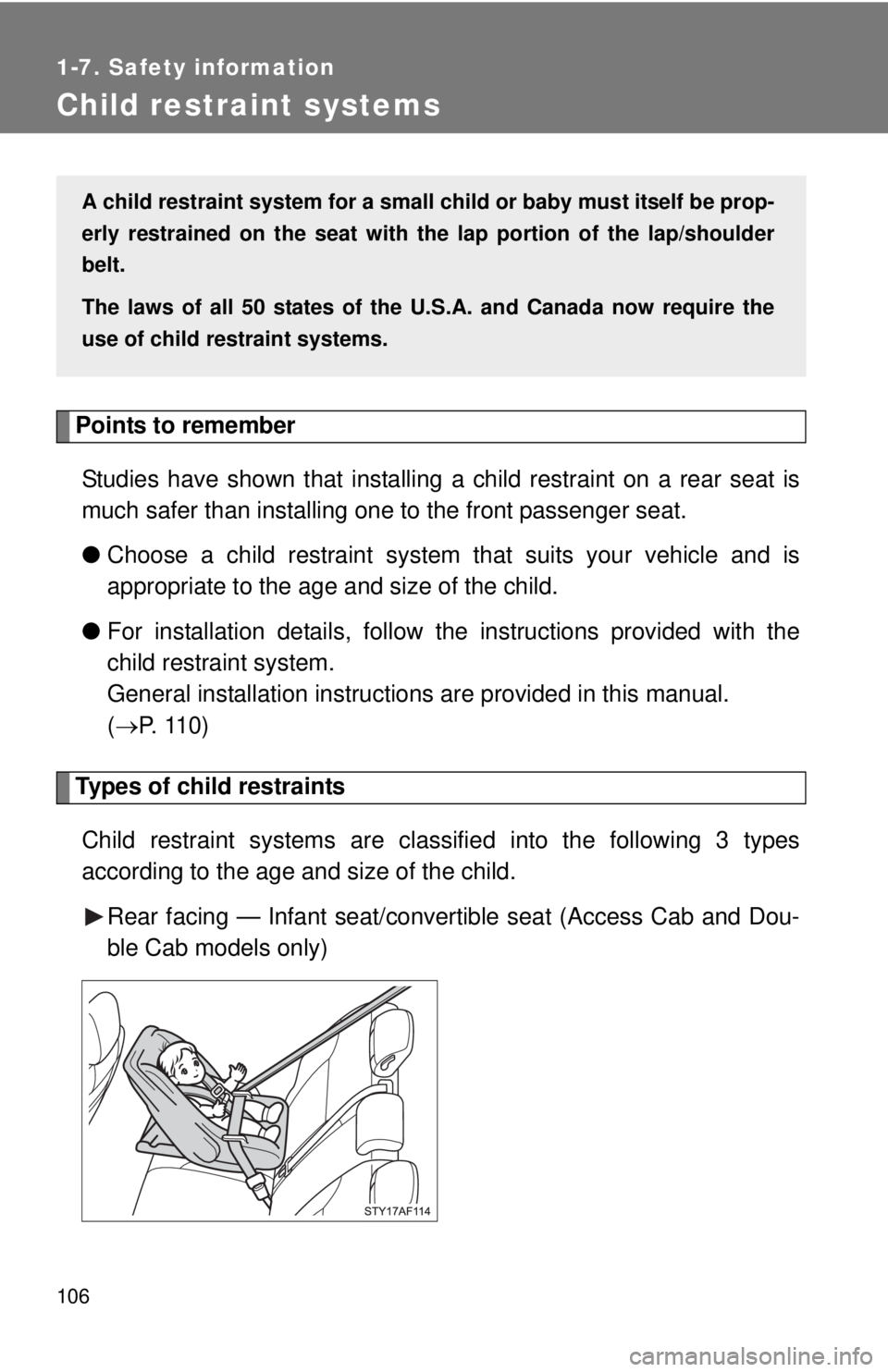
106
1-7. Safety information
Child restraint systems
Points to rememberStudies have shown that installing a child restraint on a rear seat is
much safer than installing one to the front passenger seat.
● Choose a child restraint system th at suits your vehicle and is
appropriate to the age and size of the child.
● For installation details, follow the instructions provided with the
child restraint system.
General installation instructions are provided in this manual.
( P. 110)
Types of child restraints
Child restraint systems are clas sified into the following 3 types
according to the age and size of the child.
Rear facing — Infant seat/conve rtible seat (Access Cab and Dou-
ble Cab models only)
A child restraint system for a small ch ild or baby must itself be prop-
erly restrained on the seat with the lap portion of the lap/shoulder
belt.
The laws of all 50 states of the U.S.A. and Canada now require the
use of child restraint systems.
Page 107 of 524
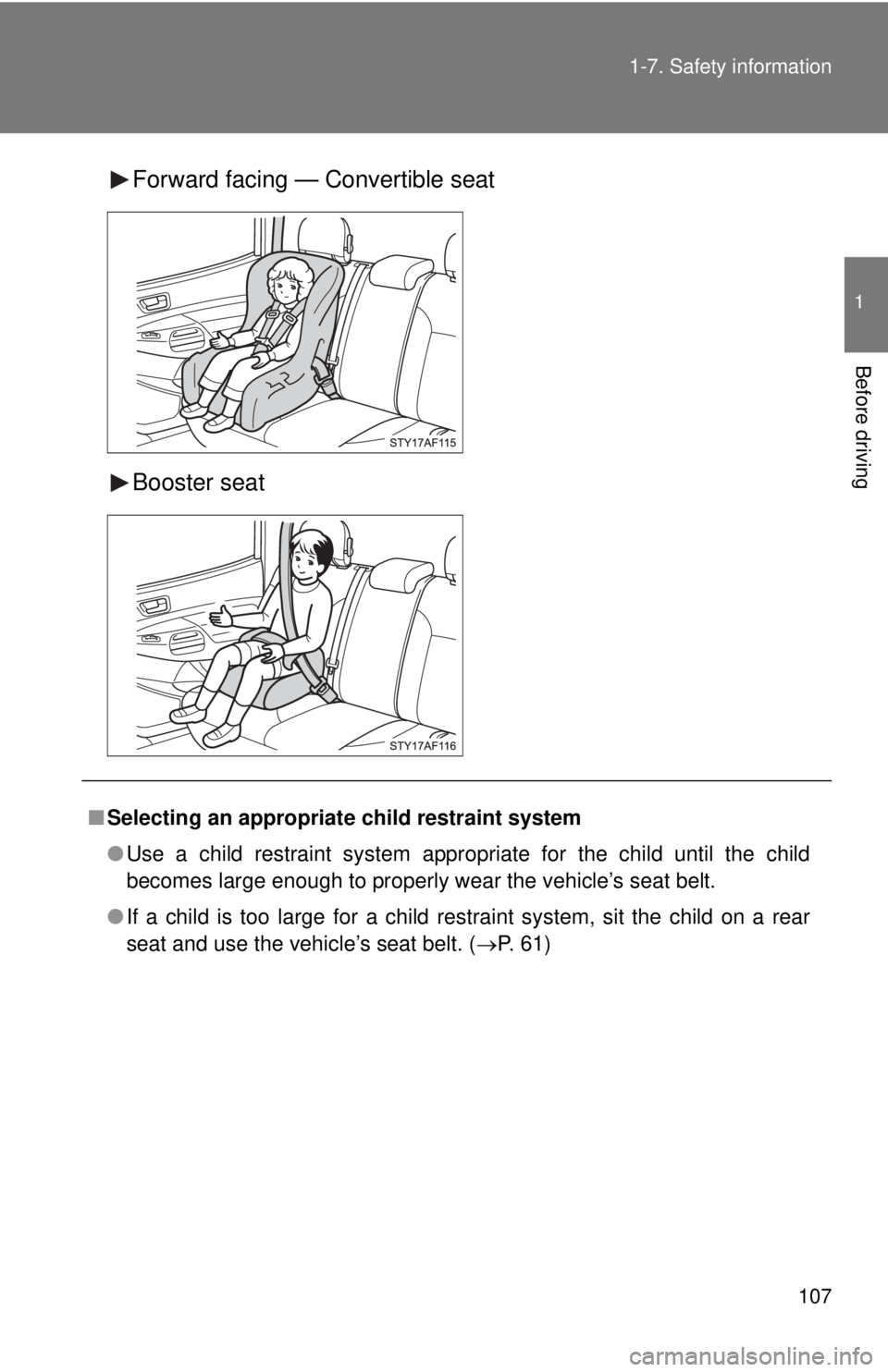
107
1-7. Safety information
1
Before driving
Forward facing — Convertible seat
Booster seat
■
Selecting an appropriat e child restraint system
● Use a child restraint system appropriate for the child until the child
becomes large enough to properly wear the vehicle’s seat belt.
● If a child is too large for a child restraint system, sit the child on a rear
seat and use the vehicle’s seat belt. ( P. 61)
Page 108 of 524
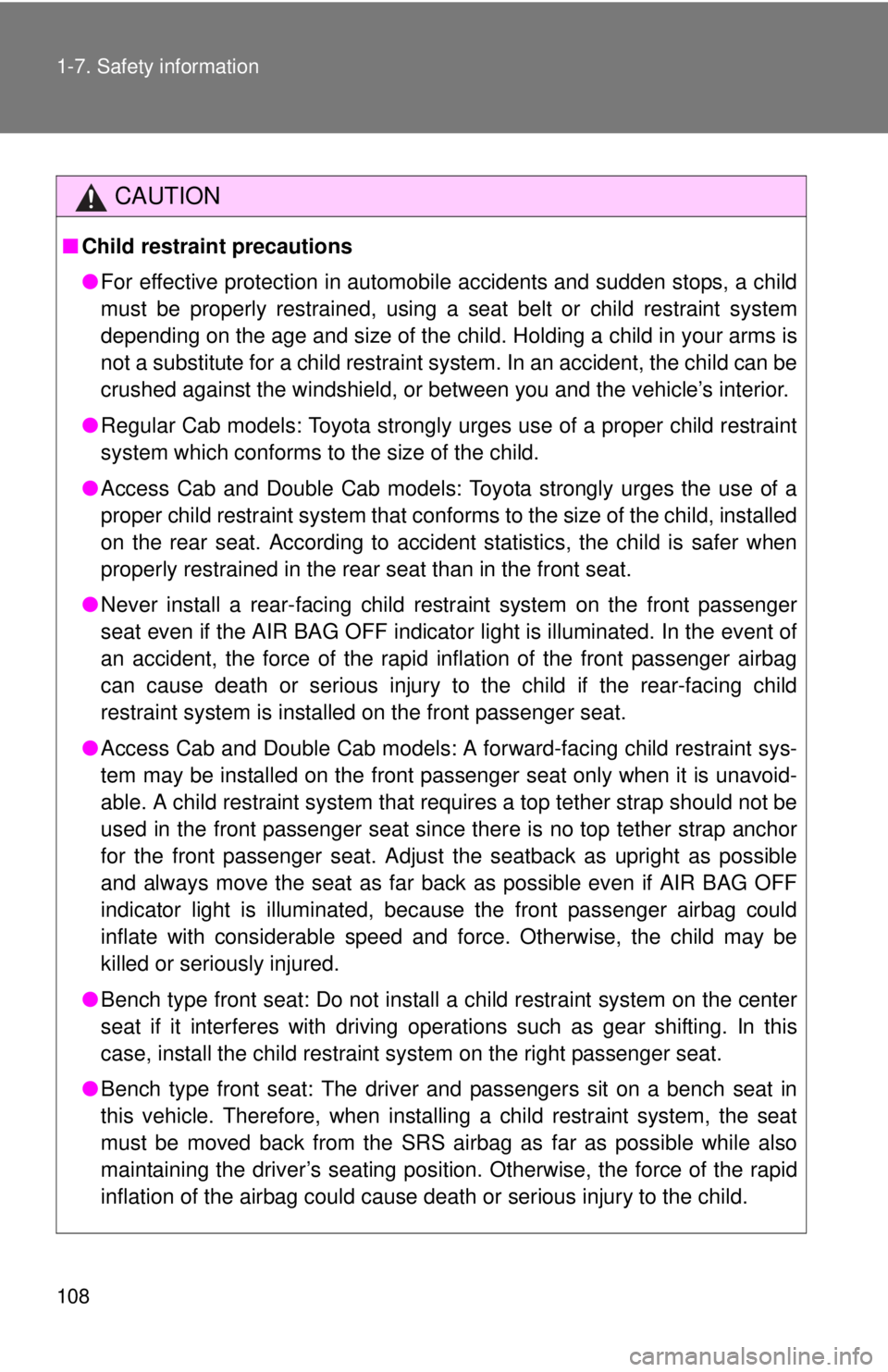
108 1-7. Safety information
CAUTION
■Child restraint precautions
●For effective protection in automobile accidents and sudden stops, a child
must be properly restrained, using a seat belt or child restraint system
depending on the age and size of the child. Holding a child in your arms is
not a substitute for a child restraint system. In an accident, the child can be
crushed against the windshield, or between you and the vehicle’s interior.
● Regular Cab models: Toyota strongly urges use of a proper child restraint
system which conforms to the size of the child.
● Access Cab and Double Cab models: Toyota strongly urges the use of a
proper child restraint system that conforms to the size of the child, installed
on the rear seat. According to accident statistics, the child is safer when
properly restrained in the rear seat than in the front seat.
● Never install a rear-facing child restraint system on the front passenger
seat even if the AIR BAG OFF indicator light is illuminated. In the event of
an accident, the force of the rapid inflation of the front passenger airbag
can cause death or serious injury to the child if the rear-facing child
restraint system is installed on the front passenger seat.
● Access Cab and Double Cab models: A forward-facing child restraint sys-
tem may be installed on the front passenger seat only when it is unavoid-
able. A child restraint system that requires a top tether strap should not be
used in the front passenger seat since there is no top tether strap anchor
for the front passenger seat. Adjust the seatback as upright as possible
and always move the seat as far back as possible even if AIR BAG OFF
indicator light is illuminated, because the front passenger airbag could
inflate with considerable speed and force. Otherwise, the child may be
killed or seriously injured.
● Bench type front seat: Do not install a child restraint system on the center
seat if it interferes with driving operations such as gear shifting. In this
case, install the child restraint system on the right passenger seat.
● Bench type front seat: The driver and passengers sit on a bench seat in
this vehicle. Therefore, when installing a child restraint system, the seat
must be moved back from the SRS airbag as far as possible while also
maintaining the driver’s seating position. Otherwise, the force of the rapid
inflation of the airbag could cause death or serious injury to the child.
Page 109 of 524
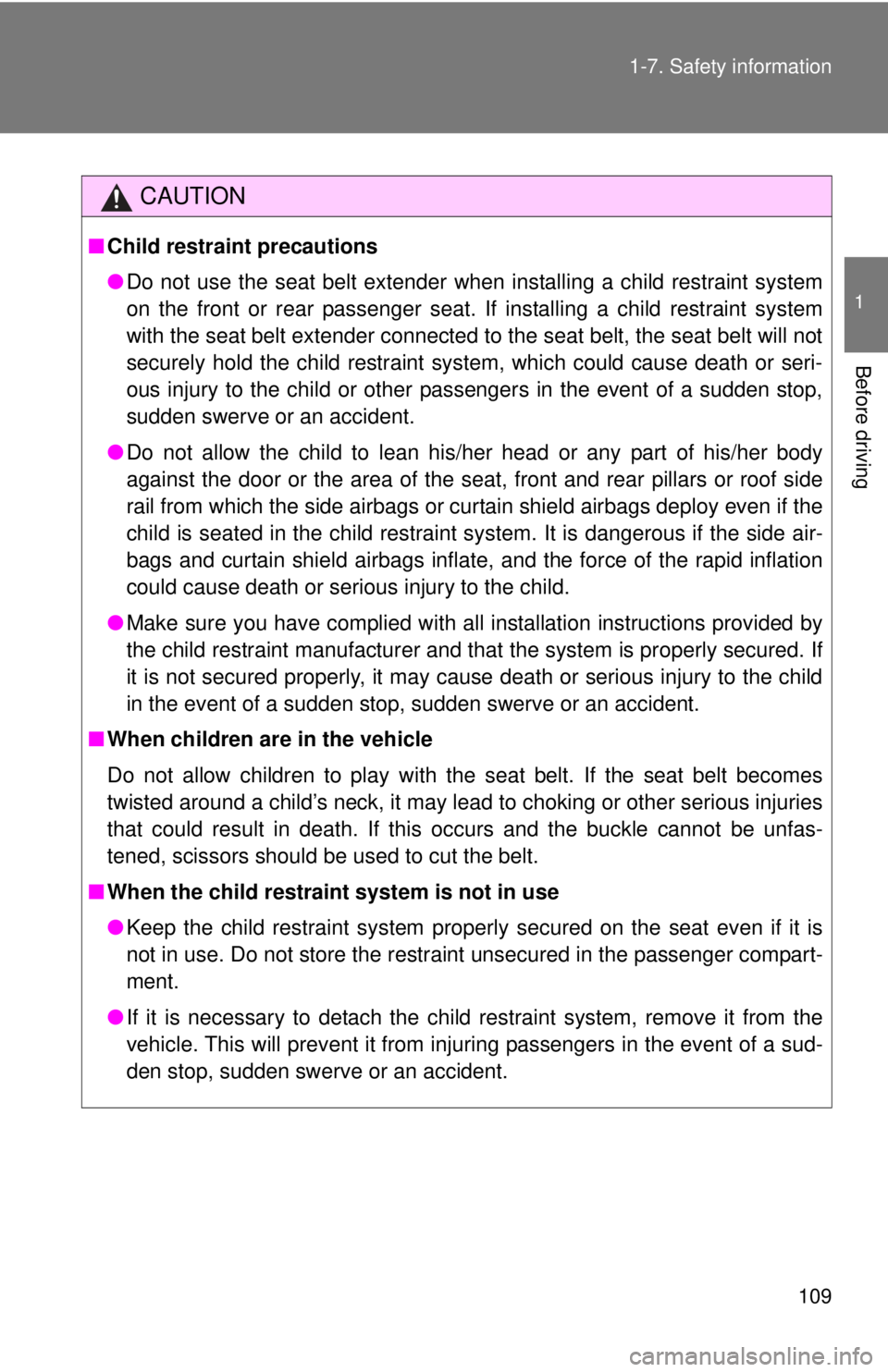
109
1-7. Safety information
1
Before driving
CAUTION
■
Child restraint precautions
●Do not use the seat belt extender when installing a child restraint system
on the front or rear passenger seat. If installing a child restraint system
with the seat belt extender connected to the seat belt, the seat belt will not
securely hold the child restraint system, which could cause death or seri-
ous injury to the child or other passengers in the event of a sudden stop,
sudden swerve or an accident.
● Do not allow the child to lean his/her head or any part of his/her body
against the door or the area of the seat , front and rear pillars or roof side
rail from which the side airbags or curtain shield airbags deploy even if the
child is seated in the child restraint system. It is dangerous if the side air-
bags and curtain shield airbags inflate, and the force of the rapid inflation
could cause death or serious injury to the child.
● Make sure you have complied with all installation instructions provided by
the child restraint manufacturer and that the system is properly secured. If
it is not secured properly, it may cause death or serious injury to the child
in the event of a sudden stop, sudden swerve or an accident.
■ When children are in the vehicle
Do not allow children to play with the seat belt. If the seat belt becomes
twisted around a child’s neck, it may lead to choking or other serious injuries
that could result in death. If this occurs and the buckle cannot be unfas-
tened, scissors should be used to cut the belt.
■ When the child restrain t system is not in use
● Keep the child restraint system properly secured on the seat even if it is
not in use. Do not store the restraint unsecured in the passenger compart-
ment.
● If it is necessary to detach the child restraint system, remove it from the
vehicle. This will prevent it from injuring passengers in the event of a sud-
den stop, sudden swerve or an accident.
Page 110 of 524
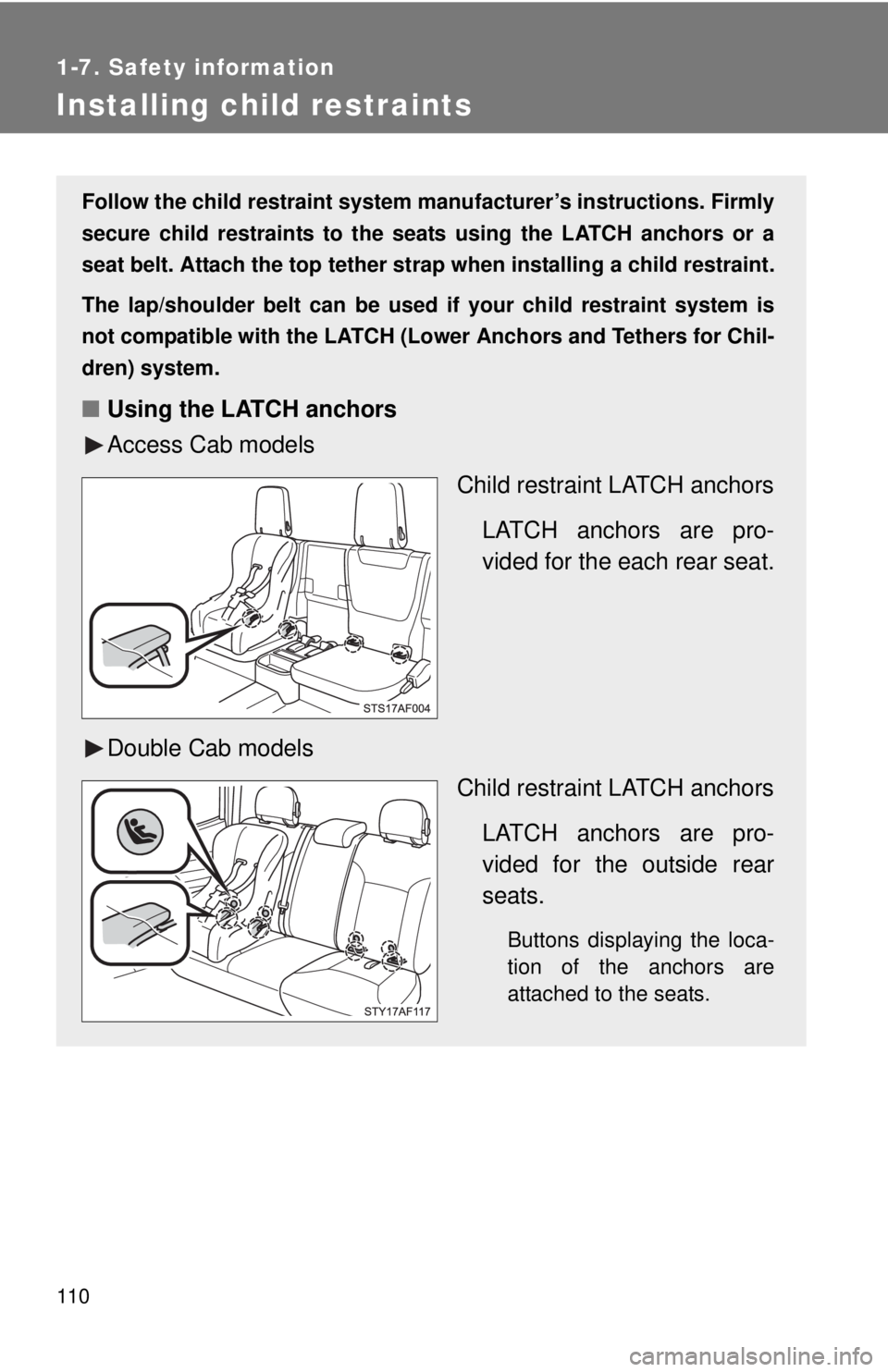
110
1-7. Safety information
Installing child restraints
Follow the child restraint system manufacturer’s instructions. Firmly
secure child restraints to the seat s using the LATCH anchors or a
seat belt. Attach the top tether stra p when installing a child restraint.
The lap/shoulder belt can be used if your child restraint system is
not compatible with the LATCH (Low er Anchors and Tethers for Chil-
dren) system.
■ Using the LATCH anchors
Access Cab models
Child restraint LATCH anchors
LATCH anchors are pro-
vided for the each rear seat.
Double Cab models Child restraint LATCH anchors
LATCH anchors are pro-
vided for the outside rear
seats.
Buttons displaying the loca-
tion of the anchors are
attached to the seats.
Page 111 of 524
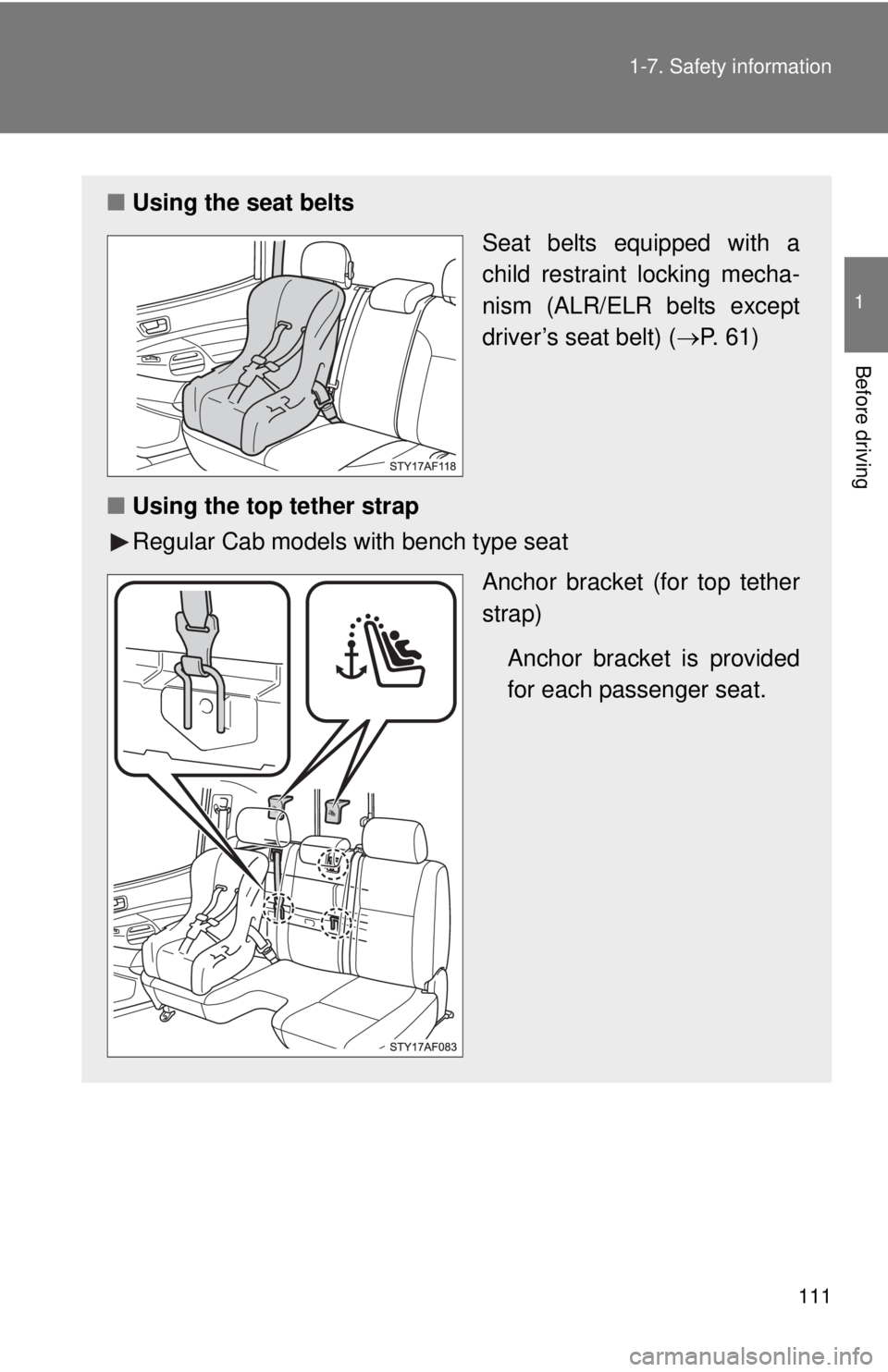
111
1-7. Safety information
1
Before driving
■
Using the seat belts
Seat belts equipped with a
child restraint locking mecha-
nism (ALR/ELR belts except
driver’s seat belt) (P. 61)
■ Using the top tether strap
Regular Cab models with bench type seat
Anchor bracket (for top tether
strap)
Anchor bracket is provided
for each passenger seat.
Page 114 of 524
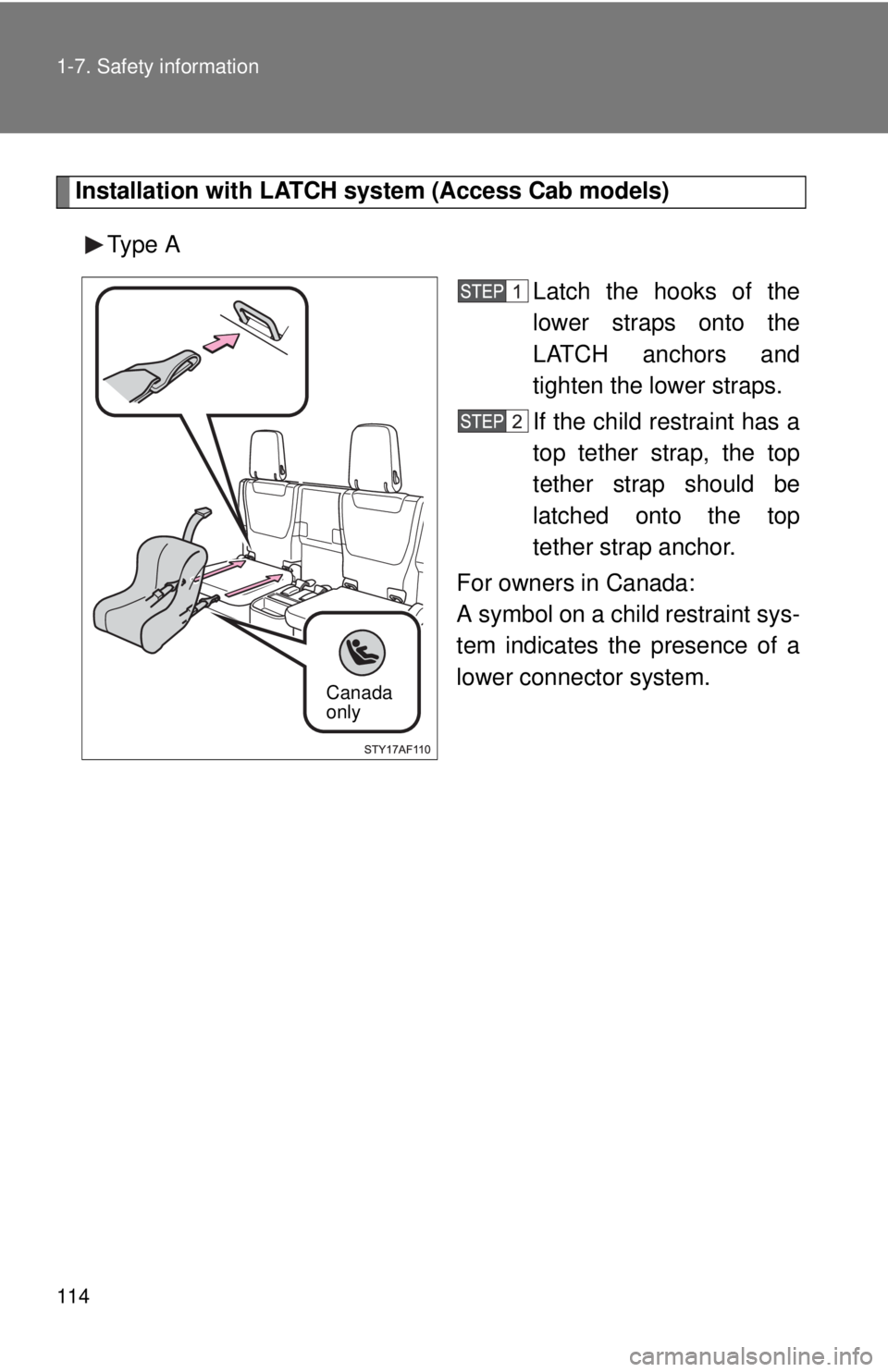
114 1-7. Safety information
Installation with LATCH system (Access Cab models)
Type A Latch the hooks of the
lower straps onto the
LATCH anchors and
tighten the lower straps.
If the child restraint has a
top tether strap, the top
tether strap should be
latched onto the top
tether strap anchor.
For owners in Canada:
A symbol on a child restraint sys-
tem indicates the presence of a
lower connector system.
Canada
only
Page 115 of 524
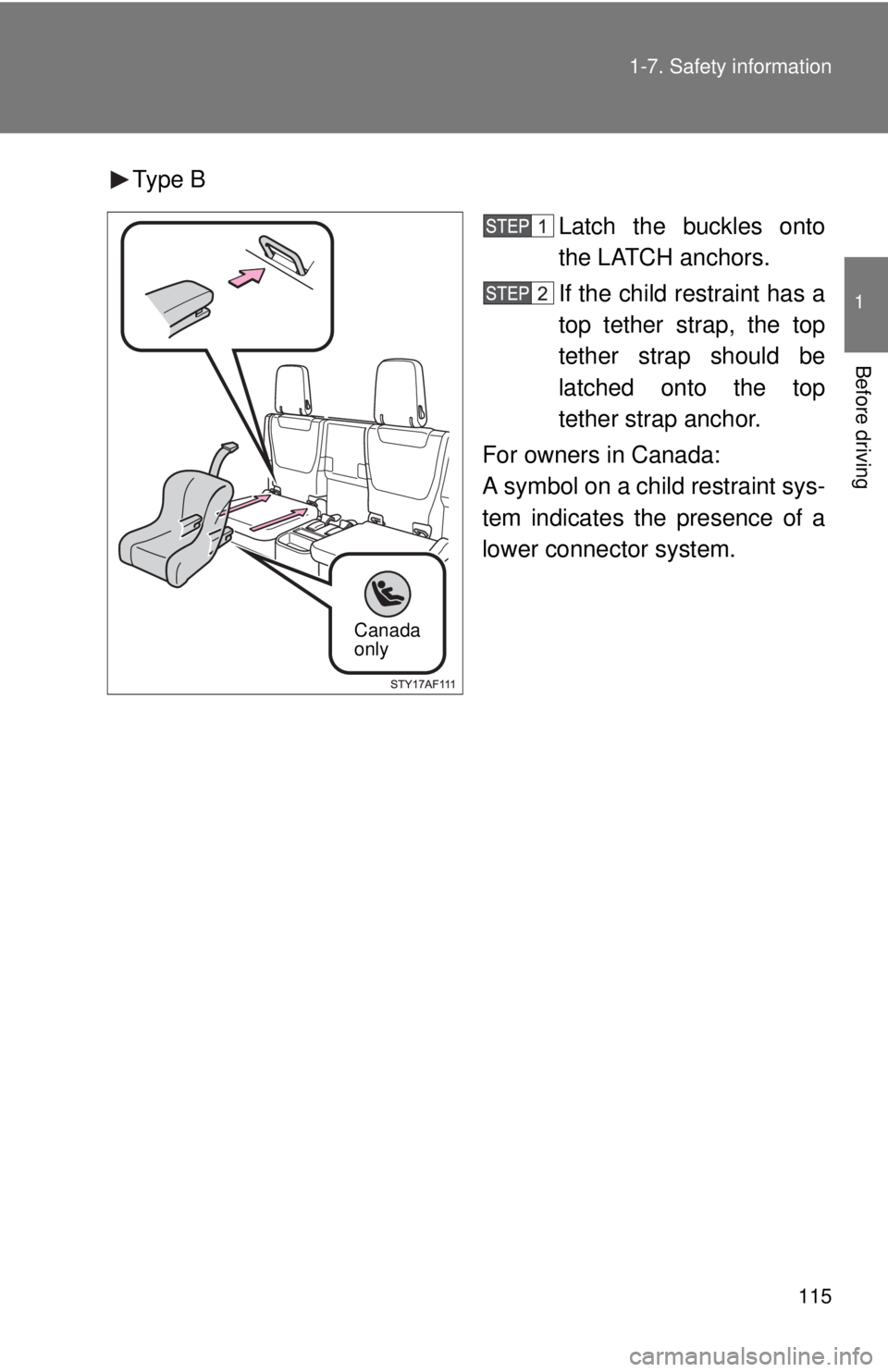
115
1-7. Safety information
1
Before driving
Type B
Latch the buckles onto
the LATCH anchors.
If the child restraint has a
top tether strap, the top
tether strap should be
latched onto the top
tether strap anchor.
For owners in Canada:
A symbol on a child restraint sys-
tem indicates the presence of a
lower connector system.
Canada
only
Page 116 of 524
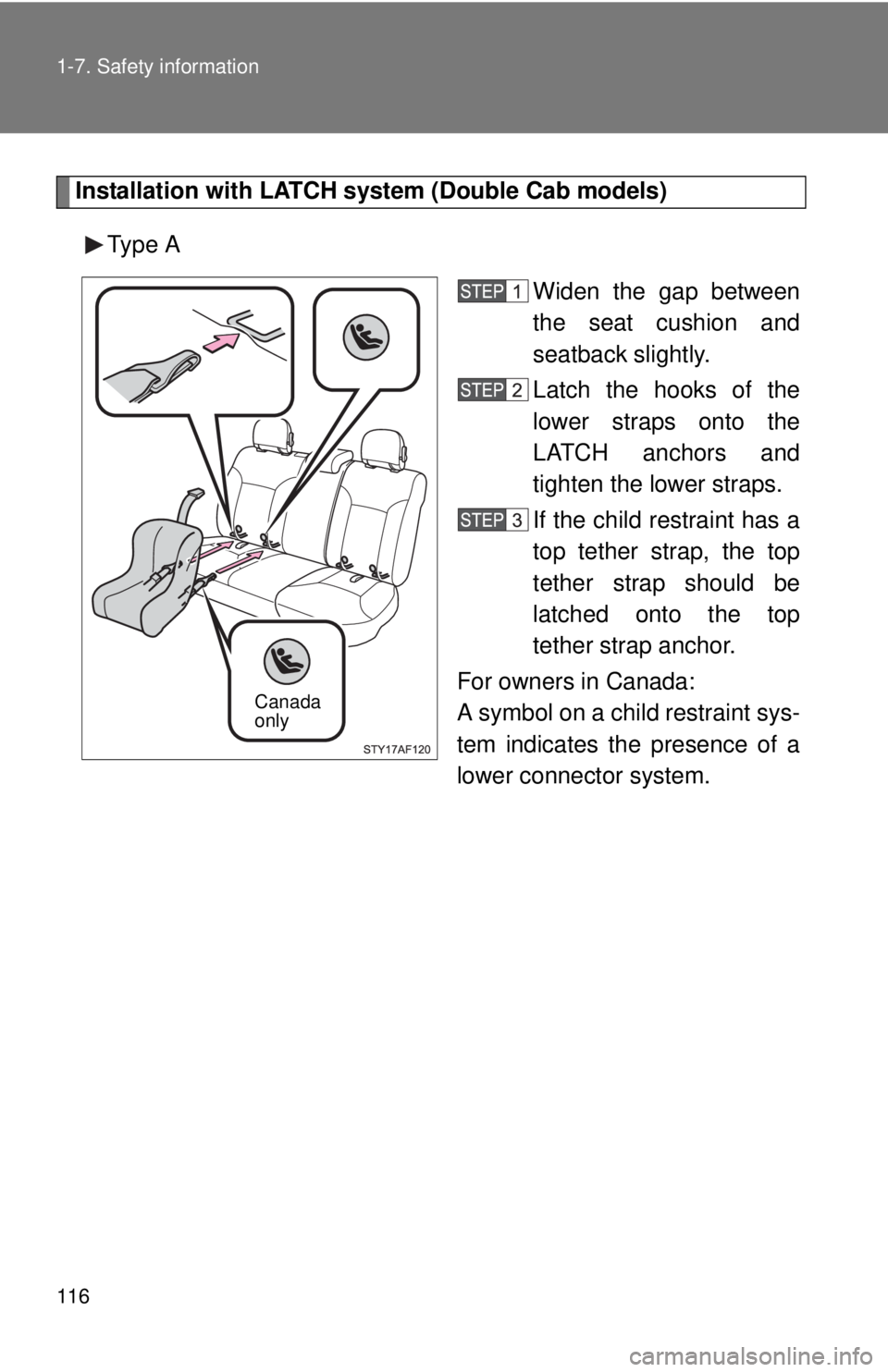
116 1-7. Safety information
Installation with LATCH system (Double Cab models)Type A Widen the gap between
the seat cushion and
seatback slightly.
Latch the hooks of the
lower straps onto the
LATCH anchors and
tighten the lower straps.
If the child restraint has a
top tether strap, the top
tether strap should be
latched onto the top
tether strap anchor.
For owners in Canada:
A symbol on a child restraint sys-
tem indicates the presence of a
lower connector system.
Canada
only
Page 117 of 524
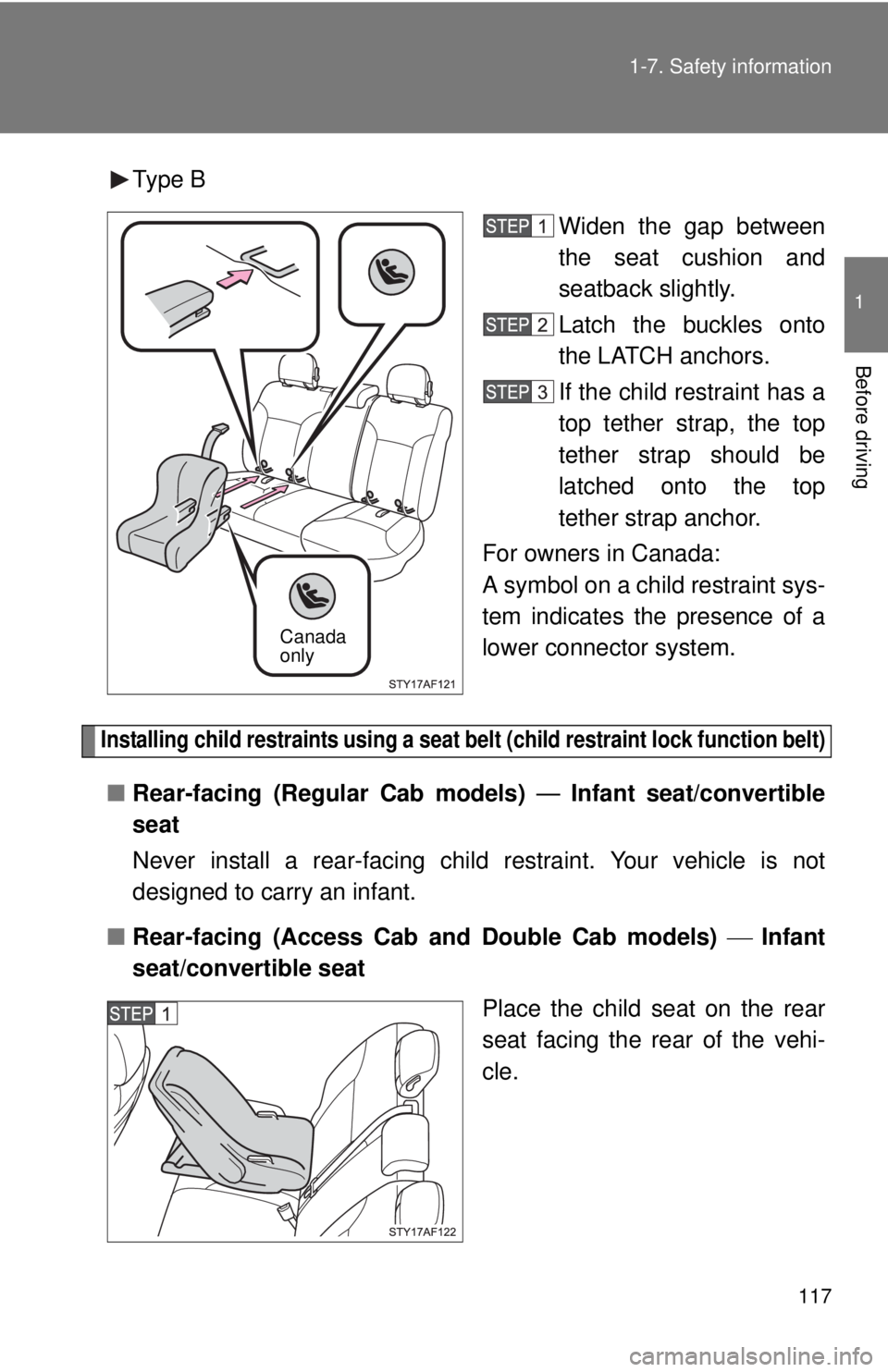
117
1-7. Safety information
1
Before driving
Type B
Widen the gap between
the seat cushion and
seatback slightly.
Latch the buckles onto
the LATCH anchors.
If the child restraint has a
top tether strap, the top
tether strap should be
latched onto the top
tether strap anchor.
For owners in Canada:
A symbol on a child restraint sys-
tem indicates the presence of a
lower connector system.
Installing child restraints using a seat belt (child restraint lock function belt)
■ Rear-facing (Regular Cab models) — Infant seat/convertible
seat
Never install a rear-facing child restraint. Your vehicle is not
designed to carry an infant.
■ Rear-facing (Access Cab and Double Cab models) Infant
seat/convertible seat
Place the child seat on the rear
seat facing the rear of the vehi-
cle.
Canada
only